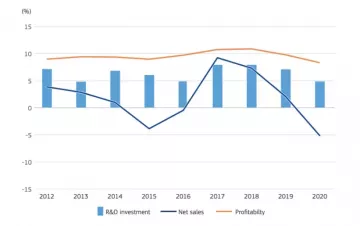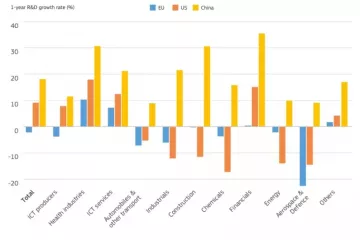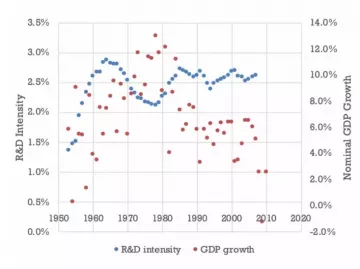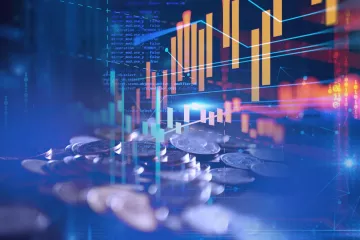Return on Investment (ROI) in Research and Development (R&D)
Methods of Evaluation and Outsourcing
Research and Development activities are traditionally viewed as determinants of a company's competitiveness, growth capacity, as in the basic definition these are the innovative, strategic actions focused on medium or long term improvements in operation, knowledge and margin of returns.
Return on Investments on Research and Development is an integral base for strategizing the R&D, and essentially represents the volume of profit gathered from each invested financial resource spent on R&D in a given time (a year).
Overview:
Companies conduct opportunity cost calculations, when making the decision on how to invest their financial resources or any other funds. Research by itself as well as the development of successful outcomes is likely to take a year or more before the tangible results occur, this may be a reason why R&D is not the main priority area to distribute the funds (typical spend on R&D in the industrial world for example is around 5 % depending on the sector, some of the leaders tend to spend even 8–10 %), but then why are so many investments still going into R&D?
Theoretically if a company indicates positive prospects, it should focus the retained earnings .{target:_blank; title:Retained earnings definition into the future well-performance of the enterprise, in other words it has appropriate grounds to Invest in R&D. Analysts, investors, accountants, general managers of operations, heads of Innovation departments and many other strategic decision makers on behalf of enterprises monitor the R&D capacity, current performance and evaluate the future possible competitiveness. Many industries and world renown companies have come to failure due to shrinking the R&D budgets – as this is an intuitive yet not a correct budget-cutting strategy, even when faced with economic turmoils, disease-caused recessions.
There are various R&D ROI metrics actively used to calculate the return from R&D investments , and just as many ways to plan these investments depending on the activities of the company – so the question is, how much clarity can one get before making the right decision? Which R&D ROI Metric to choose?
The Economy, Trends, Effects of the pandemic
R&D initiatives have to be managed very carefully in regards to the planning, which has been proven by the accumulative experiences in R&D, from different industries and companies. Despite the Covid-19 pandemic, investments in the R&D globally continued to increase vastly in 2020 making it the eleventh consecutive year of the growing R&D investments. Based on The 2021 EU industrial R&D Investment Scoreboard – companies invested € 908.9 bln in R&D, which is 6.0 % more than in the previous year. The other indicators of funds and finances show the opposite results – especially the net sales, op. Profits and capital expenditures. This is of course one of the more general indicators of growth in the demand of Research and development in the world (and this is not limited to Healthcare industry only) – the continuous drop in the net sales, yet the relatively stable profitability proves top tear companies globally made the conscious decision to protect their R&D investments.

US and China based enterprises, due to their heavy investments in IT(ICT) and Healthcare have shown the largest growth in the R&D (US – 9.1 % and China – 18.1 % respectively). The picture is different in the EU where the investments in R&D dropped by 2.2 %.
The leading sectors in the global R&D growth were ICT services (data monitoring, entry, management and processing services especially) with 15.5 % growth, with a contrasting decrease in R&D investments in Aerospace & Defense (-17.0 %) and Automotive (-4.3 %).

These ongoing factors show that global trends in the R&D investments have been hit and changed by the pandemic, however, not decreased – the R&D is and will remain alive and well, as it is an integral part of Industries’, Companies’ as well as Countries’ economy .
The importance of proper strategic focus on R&D can be visualized through individual cases as well, like the famous story of Dupont, or the an entirely customer-oriented case, for a contrast (to be sure we do not mistake the necessity of R&D for only industrial and B2B cases) – P&G’s R&D strategy with their famous Tide, the biggest household care product of P&G. This product had already been dominating the market for over 50 years, when in the 2010s the annual revenues skyrocketed from $12 billion – $24 billion, thanks to the newly ramping up growth factory. The learning has stayed with the company, and the market domination with a variety of their products is not a coincidence, as it now spends around $2 billion on R&D annually — which is nearly 50 % more than the closest competitor(and more than the combined investments of most other competitors). They went so far as to develop the interdepartmental R&D cooperation .
An interesting observation around the topic was made by the CEO Bob McDonald – “We know from our history that while promotions may win quarters, innovation wins decades.”
As alike R&D and Innovation may be, they are just as specific to the purpose they serve. DSM defined it nicely when referring to R&D as a tool that turns money into knowledge, when Innovation is the process of turning the knowledge into business. Knowledge, the resource superior to so many, is a topic to study and explore further.
How to Measure firm level returns to R&D
One of the more important methods of ROI calculations in R&D is based on Research Quotient (RQ) in the bases, which is essentially the IQ of the company. This R&D ROI metric suggests that, an individual IQ represents a person’s capacity to solve more problems per minute, the high RQ companies overcome their issues per unit of investment in R&D.
This is based on Paul Romer’s theory around connecting R&D to growth, which won the Nobel Prize in 2018 (the essence of the theory was linking a firm’s inputs to outputs). Based on the theory, the missing link between the capital and labor is knowledge, and the amount of new knowledge is a function of R&D investment volumes.
In summary, a firm’s economic well-being, or general continuous growth of the global economy is highly dependent on the continuous investments in R&D.

An interesting observation that proves the above point can be gathered from the chart showing the R&D spending from and GDP growth from 1950s to 2020s in the US. When the R&D spendings rose back up in the 70s, the GDP did not. Not only this doesn’t contradict Romer’s point, but it also proves it.
This observation showcases the decline in RQ (the R&D productivity): The GDP will grow with the R&D productivity, however it will grow with R&D spending if the productivity stays the same. This comes to prove that the growth that companies get from the R&D is 1/3rd of what it was in the 70s, and the R&D productivity has declined by 65%.
The current climate and economic analyses show that around 63% of companies are overinvesting in R&D due to the miscalculations and mismanagement of resources. On the other hand 33% of companies are underinvesting in R&D, and with up to 10% increase in R&D budgets they could earn $36 million higher profits.
So should we cut the R&D, or should we calculate it better, and invest more?
A practical use to the RQ for successful R&D Returns calculations: In simple terms, the RQ of a company is the percentage increase in revenues, expected from one percent increase in R&D.
- Planning the budget for Research and Development: A standard approach, for decades, has been to indicate the R&D budget as a % from sales, which averaged around 3% of sales. This standard approach has been set in the times where R&D productivity was at a different level (the paragraph above), and is clearly outdated in 2022.
- Knowing the company RQ lets us estimate the correct R&D investment custom-specified per the company in question. Moreover the approach can help to identify the exact division, scope of activities or industry that makes most sense for the firm to focus the investment of their funds.
- Opportunity Cost of R&D: The ROI calculations now have to win the battle in the Opportunity Cost calculations, to be able to justify the spendings exactly on R&D instead of Marketing, Manufacturing, etc.. Now that the RQ is clear, and so is the relevant levels of optimal R&D investment volumes – this is a simpler task
- Measuring the R&D returns: one of the main difficulties in the investments in R&D compared to other sectors – is the longer term uncertainty levels – a research intends to provide findings and answers that may tilt the operational processes. For this it is integral to be able to track the relevancy of continued investment in an R&D project.
Some relevant action steps include:
- Setting clear goals with the Department heads and responsible entities of the R&D project (or the ones from outsourced R&D service provider).
- Hold constant, updating meetings to overview the state of the project, the findings, and confirm the relevancy of the next steps which have been originally planned.
- Have clearly put together change-management strategies (operational, financial, legal) in case the tilt in the direction of R&D has to take place.
As simple as these may seem, they are essential pinpoints, and are commonly overlooked in R&D activities, thus harshly affecting the planned Returns, and overall outcomes.
There are other, simply Econometric approaches for standard R&D return calculations as well one of which is the Ex post evaluation(analytical method, based on the outputs of the R&D investment) and the Ex ante evaluation(a method of estimates, bases the firm’s value and market expectations to identify the returns from current (considered) investments as well as the previous investments in R&D).
Outsourcing R&D: Pros and Cons from ROI perspective
Throughout the recent decades, due to the necessity to find ways to increase R&D productivity – firms are gradually diversifying their R&D. Some redeploy the assets towards other, quick-return activities, and some go in the way of outsourcing the R&D, from custom specialists of the desired sector. This trend has been visible for mid-range companies and SMEs all the way to high-tier Tech giants, which states the fact that it is not just about narrowing the budget, but largely about increasing the efficiency of R&D (By 2023 the market of R&D outsourcing services has been showing more than 8 % of CAGR ). Good examples are Opera, which started as an outsourced R&D project of Norwegian TelCo company Telenor; Porsche with recent outsourcing of R&D from CODETE to make the DLConverter – Predictive Analysis and Pattern Learning solution. The Big Four tech companies are not ignoring the outsourced R&D capacity either, in fact Google, Amazon, Facebook and Apple are all gathering high revenues with more and more focus on external R&D. Surely Outsourcing the R&D has benefits as well as drawbacks – let us identify some, and see if there can be a middle ground.
Advantages of Outsourcing R&D:
- Talent Pool: R&D talent is essentially scientists, high-tear professionals and experts of the niche sector. To find, nurture and maintain these human resources within the company is an enormous and continued challenge. Additionally it is not likely that even the largest tech giants can concentrate the talent in one place – thus outsourcing the R&D helps getting access to better knowledge and skills. (See the PWC study on R&D outsourcing in hi-tech industries).
- Taxes and other regulations: With the Tax Credits, and regulations related to conducting R&D activities, for a vast variety of companies it makes much clearer sense to outsource the R&D especially from a financial and bureaucratic point of view. This does not only refer to the off-shore R&D outsourcing, but also within most countries (typical R&D offshoring destinations are Japan, Europe and USA).
- Non core business area: Often a company needs to upgrade a part of their operations that in core is not the essence of the business, yet not overcoming the available issues may be a high price to pay. At the same time there is no experience or skills available in the company to conduct the R&D, thus the best timely solution is outsourcing the services
- Exclusivity: When a company invests in R&D, it is often to gain competitive advantage over other players in the market, by providing something new, that is serving their client’s needs better. Often there are unique R&D tasks that not many companies can perform up to the requirements, which means that an internal R&D department would not be the solution either, thus outsourcing unique R&D services would mean gaining exclusive advantage over the competitor.
This touches upon the possibility to combine the outsourced and internal R&D capacities. It is a rapidly increasing practice – where one of the main points of outsourcing the R&D resources is focused on upgrading the internal R&D capacity. In other words an R&D service can be outsourced to better the internal R&D team knowledge, resources and efficiency.
This is one of the main areas of success in the assembly of R&D services RVmagnetics provides, in regards to the sensors and the measurement industry.
Disadvantages of Outsourcing R&D:
- Bureaucracy: Theoretically, outsourcing R&D (or, in fact, outsourcing any other activity) should be the process of increasing the efficiency, however often the opposite can occur, especially when original expectations are mismanaged, the service underestimated or not clearly understood, the nature or quality of the service misunderstood and/or mismanaged and many other operational hazards that would be easier to control in an internal company department.
- Time-sensitivity: An outsourced R&D project is often inaccurate in terms of timeline calculations, as the factors like explanation of the project to the client, shipping, description and alignment on terms & conditions of delivery are often overlooked. Additionally the time-calculations of certain projects might be different from the point of view of the project managers in both companies.
Confidentiality, Accessibility to information: Both from the point of R&D service provider and the client the confidentiality is of utmost importance. When outsourcing the R&D, especially from a company outside the country – it is essential to be able to have clear documentation and mechanisms to keep confidentiality. From the point of view of the R&D service provider the situation is similar, especially when the service is unique and involves trade secrets. In addition the R&D service provider needs clear channels and guarantees of getting proper reimbursement once the service is provided
Conclusion
In conclusion, we feel the overall topic of identifying the proper investments in R&D to ensure relevant returns has been described rather promptly in the book Killing the Golden Goose The Decline of Science in Corporate R&D. The authors (A. Arora, S. Belenzon, A. Patacconi) bring up the tendency of the larger companies(especially ones failing in the R&D strategies in the long-run) to value the “Golden Eggs” of science, research and development, while overlooking the “Golden Goose”. In other words the short-term fixed volumes of the innovation that tend to bring some value are being preferred, thus keeping these companies from larger investments in science, research and development – keeping them further from game-changing returns.
The two identified reasons are:
- Facing increasing competition – firms prefer to protect the existing knowledge and keep the investments in commercial applications rather than risk and innovate in a large scale. The basic attention on comparatively low numbers of some of the tech giants of the decade like Elon Musk, Steve Jobs or Jeff Bezos makes it clear that innovating on a large scale often involves high-risk – high-potential equations, which not many institutional investors are willing to bite.
- In the past decades (starting around the 70s) The inherent unpredictability of basic research has been harder to calculate, monitor and control for the firms, thus decreasing the motivation to deploy assets towards unclear investments. A valid example of this is Warren Buffet’s historical avoidance to invest in tech stocks, as there was no valid way to value them (although the aforementioned RQ, would vastly help him with this)
Noted by the authors – larger firms gradually rely on startups more and more for the innovation development (and startups themselves, when it comes to innovation and development, often rely on academia-based research, which, eventually is funded by public entities).
In this article we have identified that the R&D capacity of firms is not dropping globally, but rather is the ability to identify a productive R&D strategy; and clarified the ways how to comply the said planning; additionally clarified the preeminent benefits of outsourcing the R&D – with the sole reason to increase the awareness on the topic, as in the end of the day, being an R&D service provider ourselves – we have faced it all, and been directly experiencing the aforementioned aspects and bullet points along our operations.



